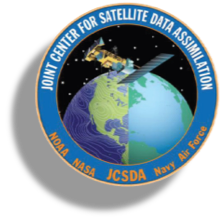Article by Dr. Hui Shao, JCSDA UFO Lead
On May 26, 2020, NWS/NCEP started operational assimilation of the GNSS radio occultation (GNSS-RO) measurements from the FORMOSAT-7/COSMIC-2 mission (COSMIC-2 hereafter) in its Global Forecast System (GFS). The COSMIC-2 mission is part of a joint agreement between the American Institute in Taiwan and the Taipei Economic and Cultural Representative Office in the United States, with NOAA and the Taiwan National Space Organization as designated representatives. The satellites are owned and operated by the Taiwan authorities. COSMIC-2 has a constellation of six satellites, providing about 5000 occultations per day concentrated between 45S-45N latitude. It was launched on June 25, 2019, and its data have been officially released to the public since March 6, 2020. The data have been available in real-time on the Global Telecommunication System (GTS) since March 16, 2020. COSMIC-2 is a follow-up mission of the FORMOSAT-3/COSMIC satellites (COSMIC-1 hereafter), which were launched on April 15, 2006 and decommissioned on May 1, 2020. Assimilation of COSMIC-2 data is helping to fill the gaps of current GNSS-RO coverage with higher data density and deeper atmospheric data penetration in (sub)tropical areas.
The implementation of COSMIC-2 assimilation is the result of close collaboration between JCSDA and its partners at NOAA (NCEP, NESDIS, OAR), as well as with UCAR collaborators. The JCSDA has led the NWP (Numerical Weather Prediction) assessment efforts as part of the Cal/Val team led by NESDIS. The JCSDA provided expertise on data quality evaluation and NWP impact studies. After COSMIC-2 was launched, several U.S. teams (including UCAR, NESDIS, Naval Research Laboratory, Air Force), working with Taiwan partners, have coordinated their efforts to assess the quality of the early data and provide feedback for data processing and releases. The JCSDA performed initial NWP impact assessments of COSMIC-2 data and provided results to the COSMIC-2 committee as part of the approval process for COSMIC-2’s provisional release in late 2019 and Neutral Atmospheric Initial Operational Capability (NA-IOC) release in early 2020.
During the R2O transition, NOAA and UCAR scientists have been working side by side to assimilate COSMIC-2 in real-time experiments, provide in-house assessment, and optimize its performance. NCEP decoding and obsproc team had put together a fast-tracked process to get the data flowing and on GTS, opening real time data access to the operational centers throughout the world. As the original developer of this GDAS GNSSRO operator, AOML/QOSAP team has been an asset in the final tuning of the operational configurations. The COSMIC-2 implementation is an excellent example of the JCSDA’s ability to foster collaboration between operational centers and the scientific community to accelerate R2O transitions. The figure below shows the impacts of COSMIC-2 on forecasts in comparison of in-situ radiosonde observations.
Figure 1. The improvement (Imp; blue) or degradation (Deg; red) of the forecast root-mean-square error (RMSE) against radiosonde observations data due to addition of COSMIC2 bending angles to the set of assimilated observations. Results are presented for the indicated variables (Q,W, Z, T, and SLP) and geographic categories at various pressure levels for forecast lengths out to five (5) days.
Since the COSMIC-1 mission, the JCSDA has been working collaboratively on GNSS-RO assimilation, which includes KOMPSAT-5 (implemented at NCEP in 2019), METOP-C, PAZ, as well as commercial data sources of GNSS-RO data. The JCSDA is also developing new and improved GNSS-RO assimilation capabilities as part of its next generation data assimilation development effort.
More information about the evaluations of COSMIC-2 data using the Joint Effort for Data assimilation Integration (JEDI) system can be found at https://www.jcsda.org/cosmic2.
More information on the COSMIC-2 implementation at NOAA can be found at https://www.noaa.gov/media-release/noaa-harnessing-power-of-new-satellite-data-hurricane-season.
More information on COSMIC-2 publicly available data can be found at https://www.cosmic.ucar.edu/what-we-do/cosmic-2/data/.

